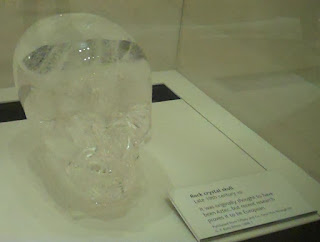The Crystal Skull in the British Museum
One of the most bizarre stories
coming out of Arizona’s Superstition Mountains, which is saying a great deal,
is that of the search for the Crystal Skull.
The Crystal Skull is said to be an ancient Aztec artifact with mystical
properties. In the summer of 1980, one
Joe Mays showed up trying to recruit guides and horses for a trek into the
mountains to hunt for the Crystal Skull.
It was July, with the temperatures hovering around 110 degrees. The locals weren’t too interested in the
Crystal Skull, but they were very interested in all of the crisp one hundred
dollar bills that Mays was splashing about.
Mays brought a small crew with him and contracted with Peralta Stables and local guides for support. He intended to go into the mountains for three weeks. As it turns out, Mays was spending money from investors, and he was spending it very lavishly, in the end some twenty thousand dollars (sixty thousand dollars in today’s money). Mays was using an “ancient book” as his bona fides for the investors.
Unfortunately
for Mays, his investors were an unsavory lot who were used to getting a high return
on their money. The investors suggested
to Mays that his next stop would be the Atlantic Ocean in a pair of cement
overshoes, unless he produced and produced fast. After a few more days of fumbling about the
Superstitions, Mays came up with a brilliant idea. He convinced the investors that they should
make a video documentary, “that would make millions!” Mays had the gift of the
gab, and the investors bought into the scheme.
The Crystal Skull has an interesting history. In the late nineteenth century, when European
interest in ancient culture was at its peak, Crystal Skulls, supposedly of
pre-Columbian Aztec or Mayan origin, began appearing in major museums in England
and France. It was one, Eugène Boban,
an antiquities dealer who opened his shop in Paris in 1870, who is most
associated with nineteenth century museum collections of Crystal Skulls. Boban is said to have tried to sell a Crystal
Skull to Mexico's national museum as an Aztec artifact, but was unsuccessful.
Boban later moved his business to New York City. A Crystal Skull was exhibited
at a meeting of the American Association for the Advancement of Science,
in New York. It was sold at auction, and bought by Tiffany and Co.,
which later sold it at cost to the British Museum in 1897.
The Crystal Skull in the Musée de l'Homme's in Paris
was donated by Alphonse Pinart, an ethnographer who had bought
it from Eugene Boban.
It was not until the twentieth century that the truth
came out. Studies demonstrated that
the skulls were manufactured in the mid-nineteenth century. The skulls were
crafted in the nineteenth century in Germany, quite likely at workshops in the
town of Idar-Oberstein, which was renowned for crafting objects made from
imported Brazilian quartz. This type of crystal was determined to be
only found in Madagascar and Brazil, and thus unknown to the
Aztecs or Maya.
In 1992,
the Smithsonian investigated a Crystal Skull provided by an anonymous
donor. Supposedly, the artifact was
of Aztec origin. The investigation concluded that this skull was made
in the 1950s or later.


No comments:
Post a Comment